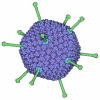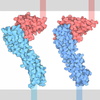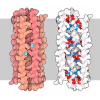[English] 日本語
 Yorodumi
Yorodumi- PDB-8z7n: Structure of HIV-1 CH119 SOSIP.664 trimer in complex with CD4 mol... -
+ Open data
Open data
- Basic information
Basic information
| Entry | Database: PDB / ID: 8z7n | ||||||
|---|---|---|---|---|---|---|---|
| Title | Structure of HIV-1 CH119 SOSIP.664 trimer in complex with CD4 molecules | ||||||
 Components Components |
| ||||||
 Keywords Keywords | VIRUS / HIV-1 / CRF_07BC / Env / CD4 | ||||||
| Function / homology |  Function and homology information Function and homology informationhelper T cell enhancement of adaptive immune response / interleukin-16 binding / interleukin-16 receptor activity / response to methamphetamine hydrochloride / maintenance of protein location in cell / cellular response to ionomycin / T cell selection / MHC class II protein binding / positive regulation of kinase activity / cellular response to granulocyte macrophage colony-stimulating factor stimulus ...helper T cell enhancement of adaptive immune response / interleukin-16 binding / interleukin-16 receptor activity / response to methamphetamine hydrochloride / maintenance of protein location in cell / cellular response to ionomycin / T cell selection / MHC class II protein binding / positive regulation of kinase activity / cellular response to granulocyte macrophage colony-stimulating factor stimulus / interleukin-15-mediated signaling pathway / positive regulation of monocyte differentiation / Nef Mediated CD4 Down-regulation / Alpha-defensins / symbiont-mediated perturbation of host defense response / regulation of T cell activation / response to vitamin D / extracellular matrix structural constituent / Other interleukin signaling / T cell receptor complex / enzyme-linked receptor protein signaling pathway / Translocation of ZAP-70 to Immunological synapse / Phosphorylation of CD3 and TCR zeta chains / positive regulation of protein kinase activity / regulation of calcium ion transport / positive regulation of calcium ion transport into cytosol / macrophage differentiation / Generation of second messenger molecules / immunoglobulin binding / T cell differentiation / Co-inhibition by PD-1 / Binding and entry of HIV virion / coreceptor activity / positive regulation of plasma membrane raft polarization / positive regulation of receptor clustering / positive regulation of T cell proliferation / positive regulation of interleukin-2 production / positive regulation of calcium-mediated signaling / cell surface receptor protein tyrosine kinase signaling pathway / protein tyrosine kinase binding / host cell endosome membrane / Vpu mediated degradation of CD4 / clathrin-coated endocytic vesicle membrane / calcium-mediated signaling / positive regulation of protein phosphorylation / MHC class II protein complex binding / transmembrane signaling receptor activity / Downstream TCR signaling / response to estradiol / Cargo recognition for clathrin-mediated endocytosis / signaling receptor activity / Clathrin-mediated endocytosis / virus receptor activity / response to ethanol / defense response to Gram-negative bacterium / clathrin-dependent endocytosis of virus by host cell / adaptive immune response / positive regulation of viral entry into host cell / early endosome / cell surface receptor signaling pathway / positive regulation of ERK1 and ERK2 cascade / positive regulation of canonical NF-kappaB signal transduction / cell adhesion / positive regulation of MAPK cascade / viral protein processing / immune response / membrane raft / endoplasmic reticulum lumen / fusion of virus membrane with host plasma membrane / external side of plasma membrane / fusion of virus membrane with host endosome membrane / viral envelope / lipid binding / symbiont entry into host cell / protein kinase binding / endoplasmic reticulum membrane / positive regulation of DNA-templated transcription / virion attachment to host cell / host cell plasma membrane / virion membrane / structural molecule activity / enzyme binding / signal transduction / protein homodimerization activity / zinc ion binding / identical protein binding / membrane / plasma membrane Similarity search - Function | ||||||
| Biological species |   Human immunodeficiency virus 1 Human immunodeficiency virus 1 Homo sapiens (human) Homo sapiens (human) | ||||||
| Method | ELECTRON MICROSCOPY / single particle reconstruction / cryo EM / Resolution: 3.58 Å | ||||||
 Authors Authors | Li, D. / Wang, T. | ||||||
| Funding support |  China, 1items China, 1items
| ||||||
 Citation Citation |  Journal: Biochem Biophys Res Commun / Year: 2024 Journal: Biochem Biophys Res Commun / Year: 2024Title: Intermediate open state of CD4-bound HIV-1 env heterotrimers in asia CRFs. Authors: Dan Li / Li Liu / Xuejun Ye / Yuyang Chen / Qiaoju Ren / ShaoJian Xu / Yan Ren / He Cao / Tao Wang /  Abstract: The HIV-1 envelope glycoprotein (Env) plays crucial role in viral infection by facilitating viral attachment to host cells and inducing fusion of the virus with the host cell membrane. This fusion ...The HIV-1 envelope glycoprotein (Env) plays crucial role in viral infection by facilitating viral attachment to host cells and inducing fusion of the virus with the host cell membrane. This fusion allows the HIV-1 viral genome to enter the target cell then triggering various stages of the viral life cycle. The native Env directly interacts with the main receptor CD4 and the co-receptor (CCR5 or CXCR4) in human cell membrane then induces membrane fusion. The elucidation of the structure of Env with CD4 and co-receptors in different HIV-1 subtypes is essential for the understanding of the mechanism of virus entry. Here we report the Cryo-EM structure of the CD4-bound HIV-1 heterotrimeric Env from Asia prevalent CRF07_BC CH119 strain. In this structure, the binding of three CD4 molecules with Env induced extensively conformational changes in gp120, resulting in the transformation of the Env from close state to intermediate open state. Additionally, the conformational shift of V1/V2 loops of the heterotrimeric Env allosterically expose the V3 loop and promoting the further interactions with co-receptor CCR5 or CXCR4. These findings not only illustrate the structural complexity and plasticity of HIV-1 Env but also give new insights how the biological trimeric Env initialize the immune recognition and membrane fusion. | ||||||
| History |
|
- Structure visualization
Structure visualization
| Structure viewer | Molecule:  Molmil Molmil Jmol/JSmol Jmol/JSmol |
|---|
- Downloads & links
Downloads & links
- Download
Download
| PDBx/mmCIF format |  8z7n.cif.gz 8z7n.cif.gz | 400.1 KB | Display |  PDBx/mmCIF format PDBx/mmCIF format |
|---|---|---|---|---|
| PDB format |  pdb8z7n.ent.gz pdb8z7n.ent.gz | 310.6 KB | Display |  PDB format PDB format |
| PDBx/mmJSON format |  8z7n.json.gz 8z7n.json.gz | Tree view |  PDBx/mmJSON format PDBx/mmJSON format | |
| Others |  Other downloads Other downloads |
-Validation report
| Summary document |  8z7n_validation.pdf.gz 8z7n_validation.pdf.gz | 1.8 MB | Display |  wwPDB validaton report wwPDB validaton report |
|---|---|---|---|---|
| Full document |  8z7n_full_validation.pdf.gz 8z7n_full_validation.pdf.gz | 1.9 MB | Display | |
| Data in XML |  8z7n_validation.xml.gz 8z7n_validation.xml.gz | 92.4 KB | Display | |
| Data in CIF |  8z7n_validation.cif.gz 8z7n_validation.cif.gz | 132.4 KB | Display | |
| Arichive directory |  https://data.pdbj.org/pub/pdb/validation_reports/z7/8z7n https://data.pdbj.org/pub/pdb/validation_reports/z7/8z7n ftp://data.pdbj.org/pub/pdb/validation_reports/z7/8z7n ftp://data.pdbj.org/pub/pdb/validation_reports/z7/8z7n | HTTPS FTP |
-Related structure data
| Related structure data |  39820MC M: map data used to model this data C: citing same article ( |
|---|---|
| Similar structure data | Similarity search - Function & homology  F&H Search F&H Search |
- Links
Links
- Assembly
Assembly
| Deposited unit | 
|
|---|---|
| 1 |
|
- Components
Components
| #1: Protein | Mass: 58258.125 Da / Num. of mol.: 3 / Mutation: A507C Source method: isolated from a genetically manipulated source Source: (gene. exp.)   Human immunodeficiency virus 1 / Gene: env / Cell line (production host): HEK293 / Production host: Human immunodeficiency virus 1 / Gene: env / Cell line (production host): HEK293 / Production host:  Homo sapiens (human) / References: UniProt: A1EAH4 Homo sapiens (human) / References: UniProt: A1EAH4#2: Protein | Mass: 18285.703 Da / Num. of mol.: 3 / Mutation: I48P,T94C Source method: isolated from a genetically manipulated source Source: (gene. exp.)   Human immunodeficiency virus 1 / Gene: env / Cell line (production host): HEK293 / Production host: Human immunodeficiency virus 1 / Gene: env / Cell line (production host): HEK293 / Production host:  Homo sapiens (human) / References: UniProt: A1EAH4 Homo sapiens (human) / References: UniProt: A1EAH4#3: Protein | Mass: 44675.320 Da / Num. of mol.: 3 Source method: isolated from a genetically manipulated source Source: (gene. exp.)  Homo sapiens (human) / Gene: CD4 / Cell line (production host): HEK293 / Production host: Homo sapiens (human) / Gene: CD4 / Cell line (production host): HEK293 / Production host:  Homo sapiens (human) / References: UniProt: P01730 Homo sapiens (human) / References: UniProt: P01730#4: Sugar | ChemComp-NAG / Has ligand of interest | Y | Has protein modification | Y | |
|---|
-Experimental details
-Experiment
| Experiment | Method: ELECTRON MICROSCOPY |
|---|---|
| EM experiment | Aggregation state: PARTICLE / 3D reconstruction method: single particle reconstruction |
- Sample preparation
Sample preparation
| Component | Name: Structure of HIV-1 CH119 SOSIP.664 trimer in complex with CD4 molecules Type: COMPLEX / Entity ID: #1-#3 / Source: RECOMBINANT |
|---|---|
| Source (natural) | Organism:   Human immunodeficiency virus 1 Human immunodeficiency virus 1 |
| Source (recombinant) | Organism:  Homo sapiens (human) Homo sapiens (human) |
| Buffer solution | pH: 7.5 |
| Specimen | Conc.: 1 mg/ml / Embedding applied: NO / Shadowing applied: NO / Staining applied: NO / Vitrification applied: YES |
| Vitrification | Cryogen name: ETHANE |
- Electron microscopy imaging
Electron microscopy imaging
| Experimental equipment |  Model: Titan Krios / Image courtesy: FEI Company |
|---|---|
| Microscopy | Model: FEI TITAN KRIOS |
| Electron gun | Electron source:  FIELD EMISSION GUN / Accelerating voltage: 300 kV / Illumination mode: FLOOD BEAM FIELD EMISSION GUN / Accelerating voltage: 300 kV / Illumination mode: FLOOD BEAM |
| Electron lens | Mode: BRIGHT FIELD / Nominal defocus max: 2400 nm / Nominal defocus min: 1000 nm |
| Image recording | Electron dose: 50.8 e/Å2 / Film or detector model: GATAN K3 (6k x 4k) |
- Processing
Processing
| CTF correction | Type: PHASE FLIPPING AND AMPLITUDE CORRECTION | ||||||||||||||||||||||||
|---|---|---|---|---|---|---|---|---|---|---|---|---|---|---|---|---|---|---|---|---|---|---|---|---|---|
| Symmetry | Point symmetry: C1 (asymmetric) | ||||||||||||||||||||||||
| 3D reconstruction | Resolution: 3.58 Å / Resolution method: FSC 0.143 CUT-OFF / Num. of particles: 1045667 / Symmetry type: POINT | ||||||||||||||||||||||||
| Refine LS restraints |
|
 Movie
Movie Controller
Controller


 PDBj
PDBj



















